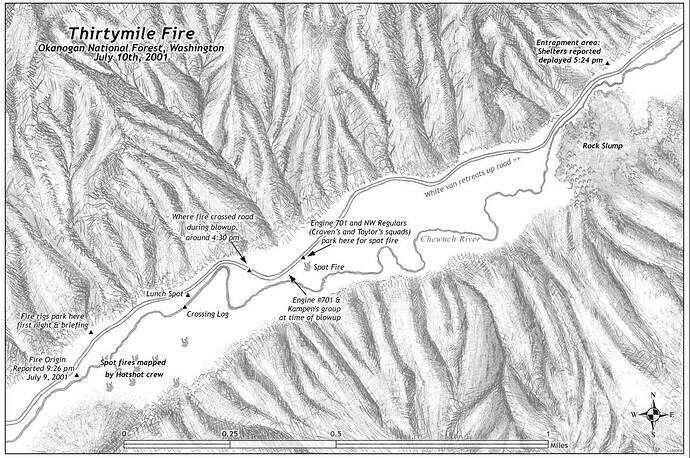Here is a map I made for John Maclean’s Thirtymile book. Feel free to print it out for teaching or discussion.
I think you must read the book and realize “what would you guys do?” Requires about 20 answers. In terms of the deployment and escaping the thermal insult staying on a flat surface like the road the survivors deployed on is always better than being on a slope especially one littered with rocks making sealing your shelter to the ground impossible. Its been 8 years since I read the book but iirc the van did not burn down. Everyone stays in the van and puts shelters up in the windows? Go the the creek and wade in the water with shelter over my head? I dont know how dewp it is. The creek is gonna be the lowest part of the valley with the coolest air albeit still very hot. My son is thinking about getting into wildand fire and incidents like this scare me. The lack of preparedness and C2 is what ultimately killed those folks.
https://www.fs.fed.us/t-d/pubs/htmlpubs/htm09512318/index.htm
“Deploying Your Fire Shelter in a Body of Water”
Highlights…
During July 2007, nine firefighters deployed fire shelters in a small pond during the Seven Oak Fire in California.
Deploying a fire shelter in a body of water can expose firefighters to additional safety hazards.
This tech tip discusses some of the hazards of deploying a fire shelter in water and some of the precautions firefighters should take if they are considering doing so.
To me it seems like a slam-dunk. We’re made of water. Surrounded by enough water is functionally a heat sink. The tech tip says 18" or better. Of course, you can lose your footing, shelter isn’t designed to deal with hypothermia, etc… but people have survived in swimming pools, underneath upside-down small boats, and even inside plastic water tanks (!) The problem is that awkward breathing thing.
20 year anniversary of this incident today. I was a part of this NW Regulars crew for several assignments from 98-00 as an FS employee out of Leavenworth. Knew and worked with several folks who were on the roster for this fire. It’s crazy to think back how 9/11 and this incident happened only a couple months apart. I feel like we’ve reframed the risk/reward calculus quite a bit since this incident, but looking back, those days we used the FIRE ORDERS acronym as opposed to the rearranged modern Keep…, Know…, Base…, etc… order. I just can’t help but feel that the “F- Fight fire aggressively, but provide for safety first” was not appropriately heeded given the values at risk, and there were likely numerous contributing human factors associated with this tragedy that the Fireline Leadership type classes have now done a better job of addressing. Locally, the successive abolition of the multi district throw together Regulars crew structure in favor of organized 10-20 person modules was probably the most important organizational change that followed the incident, but I’m unsure whether that was related to the incident of just the budget getting bigger after the 2000 season. Be safe and take care of eachother.

